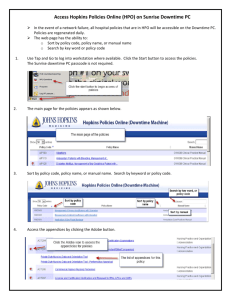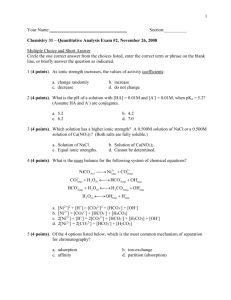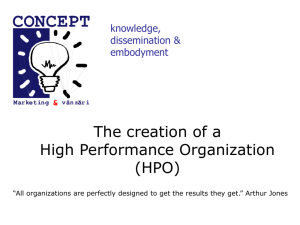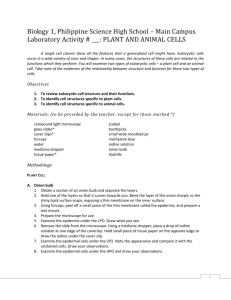The Characteristics of a High Performance Organization
advertisement
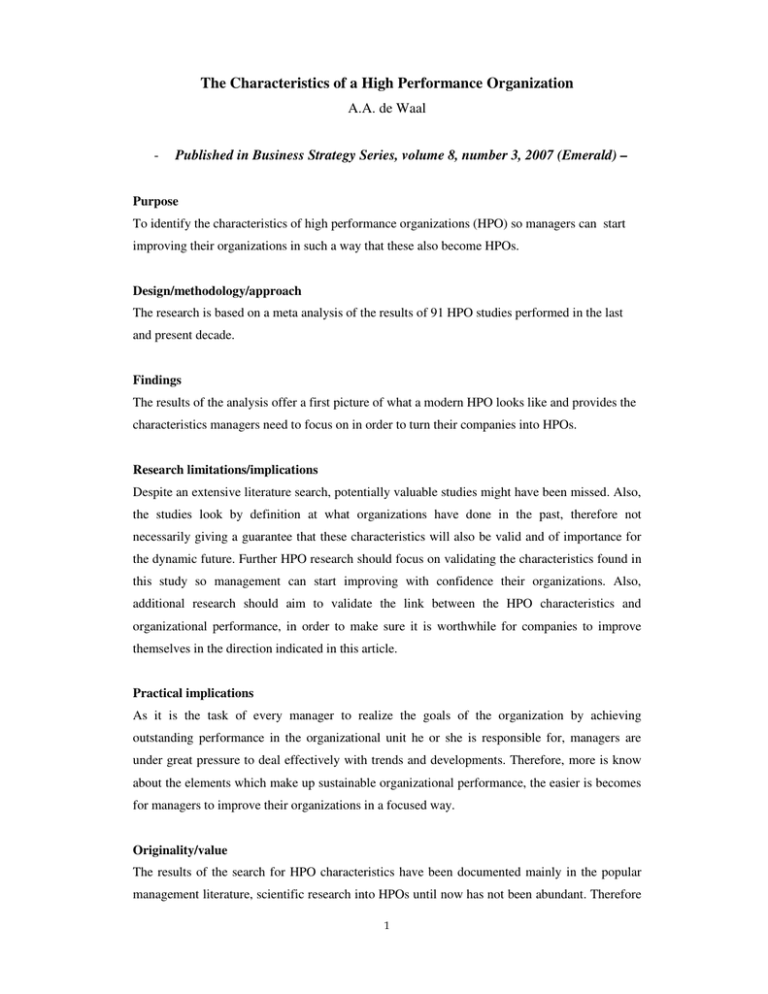
The Characteristics of a High Performance Organization A.A. de Waal - Published in Business Strategy Series, volume 8, number 3, 2007 (Emerald) – Purpose To identify the characteristics of high performance organizations (HPO) so managers can start improving their organizations in such a way that these also become HPOs. Design/methodology/approach The research is based on a meta analysis of the results of 91 HPO studies performed in the last and present decade. Findings The results of the analysis offer a first picture of what a modern HPO looks like and provides the characteristics managers need to focus on in order to turn their companies into HPOs. Research limitations/implications Despite an extensive literature search, potentially valuable studies might have been missed. Also, the studies look by definition at what organizations have done in the past, therefore not necessarily giving a guarantee that these characteristics will also be valid and of importance for the dynamic future. Further HPO research should focus on validating the characteristics found in this study so management can start improving with confidence their organizations. Also, additional research should aim to validate the link between the HPO characteristics and organizational performance, in order to make sure it is worthwhile for companies to improve themselves in the direction indicated in this article. Practical implications As it is the task of every manager to realize the goals of the organization by achieving outstanding performance in the organizational unit he or she is responsible for, managers are under great pressure to deal effectively with trends and developments. Therefore, more is know about the elements which make up sustainable organizational performance, the easier is becomes for managers to improve their organizations in a focused way. Originality/value The results of the search for HPO characteristics have been documented mainly in the popular management literature, scientific research into HPOs until now has not been abundant. Therefore 1 most evidence is anecdotic from nature, consisting of surveys and case studies. The research described in this article forms the start of a thorough investigation of HPO characteristics which is executed in a scientific way while at the same time yielding practical results with which managers can start improving their organizations. Abstract Ever since the publication of Peters and Waterman’s landmark study In Search Of Excellence (1982) and the bestsellers Built To Last and Good to Great of Collins (1997, 2001), there has been a strong interest in identifying the characteristics of high performance organizations (HPOs). This interest has been fired by the rapid changes in the competitive environment of companies and the pressure of ever increasing demands of the external environment and stakeholders. By identifying the characteristics of HPOs, organizations hope to be able to improve themselves in a focus way so they can start achieving sustainable performance. This article describes the results of a meta analysis of 91 studies into high performance organizations (performed since 1992). The analysis yielded characteristics with regard to the organizational design, structure, processes, technology, leadership, people, and culture, and the external environment which seem to influence the ability of organizations to achieve high performance. These characteristics can guide managers as to which actions they need to take to lead their organizations to superior results. 2 INTRODUCTION In the wake of Peters and Waterman’s landmark study In Search Of Excellence (1982) and the bestsellers Built To Last (Collins and Porras, 1997) and Good to Great (Collins, 2001), there has been a strong interest in identifying the characteristics of high performance organizations (HPOs). This interest has been fired by the rapid changes in the competitive environment of companies (Laudicina, 2005), forcing them to “adapt faster and faster to growing international demands for flexibility and speed and to compete simultaneously on the basis of development cycle time, price, quality, flexibility, fast and reliable delivery, and after-sales support for their products” (Kasarda and Rondinelli, 1998). As a result of the changes in industry and society, governmental agencies too are subject to changes. They have to rapidly reshape themselves into nimble and flexible organizations which put the interests of citizens central, a movement which is known as New Public Management (Zeppou and Sotirakou, 2002; Pollitt, 2003). This article describes the results of a meta analysis of HPO studies that have been published the past fifteen years in the literature. From the analysis several characteristics appear that seem to be decisive factors for achieving lasting good performance. Basis for the meta analysis is an extensive search of both the scientific and popular management literature. Criteria for including studies in the analysis were: 1. The study has been performed in the last or present decade (no earlier than 1990) and is aimed specifically at identifying HPO characteristics or best practices in certain aspects of business (such as processes, human resources, or technology) which are explicitly linked to achieving high performance. Reason for the chosen time period is that there have been so many changes the last decade in the competitive landscape (more globalization, increased competitive and legislatory pressures, shorter product and organizational life cycles, more independent and self-assured employees) that it is assumed that these changes render the results of studies older than ten years largely invalid or at least less relevant. 2. The study consists of either a survey with a sufficient number of respondents so that its results can be assumed to be (fairly) representative, or of in-depth case studies of several companies so the results are at least valid for more than a single organization. 3. The written documentation contains an account and justification of the research method, research approach and selection of the research population, a clear analysis, and clear retraceable conclusions and results. This way, the quality of the research can be assessed. No distinction was made in the industries of the organizations studied or the countries these companies are established. These distinctions could be the topic of further study. Based on the 3 described criteria, the literature search yielded 91 studies which satisfied the criteria completely or partly.1 Three types of studies can be distinguished: A. A study which satisfies all three criteria. These studies form the basis for the identification of HPO characteristics. Thirty-six of these A studies were found. B. A study which satisfies criterion 1 and 2 but only partly criterion 3, because although the research approach seems (fairly) thorough there is no clear description and justification of the method used. These studies form an additional input to the identification of HPO characteristics. Twenty-five of these B studies were found. C. A study which basically satisfies criteria 1 and 2 but not criterion 3, so there is no basis for generalizing the study findings. These studies can be used as further support for HPO characteristics identified in category A and B studies. Thirty of these C studies were found. HPO DEFINITION AND FRAMEWORK Many definitions of a high performance organization can be found in the literature. These definitions often describe achievements or attributes of a HPO such as: strong financial results, satisfied customers and employees, high levels of individual initiative, productivity and innovation, aligned performance measurement and reward systems, and strong leadership (Epstein, 2004). A way to proceed to a general definition is to identify common themes in the definitions given in the A, B and C studies and to compose a uniform definition based on these common themes. In this way, the following themes can be discerned: − a HPO achieves sustained growth, which is better than the financial performance of its peer group over a period of at least five years; − a HPO has a great ability to adapt quickly to changes; − a HPO has a long-term orientation; − the management processes of an HPO are integrated and the strategy, structure, processes and people are aligned throughout the organization; − a HPO focuses on continuously improving and reinventing its core capabilities; − a HPO spends much effort on developing its workforce. Based on the common themes, the following definition of an HPO is proposed: A High Performance Organization is an organization that achieves financial results that are better than those of its peer group over a longer period of time, by being able to adapt well to changes and react to these quickly, by managing for the long term, by setting up an integrated and aligned management structure, by continuously improving its core capabilities, and by truly treating the employees as its main asset. 1 A complete overview of the 91 studies can be found in Waal, A.A. de (2005), The foundations of Nirvana, the characteristics of a high performance organisation, white paper, www.andredewaal.nl 4 In order to categorize the characteristics of an HPO, the framework of Kotter and Heskett (1992) is combined with that of Scott Morton (2003). The Kotter and Heskett framework defines four factors which influence the behavior of people in organizations: organizational culture; organizational structure (formal structure, systems, processes and policies); leadership of the organization; and external environment (competitors/comparable organizations, public and legislative organizations). Scott Morton’s framework enlarges the external environment factor by adding customers, suppliers and partners, and broadens the framework by putting individuals & roles into it and by specifically adding strategy, organizational design and technology to the organizational structure factor. The factors in the resulting framework (Exhibit 1) influence the degree in which organizational members exhibit performance-driven behavior which in turn designates whether the organization is an HPO (De Waal, 2004). External orientation Organizational structure • • • • Organizational design Strategy Process management Behavior Technology of organizational members Organizational culture • • • High Performance Organization Leadership Individuals & Roles Culture Exhibit 1: Framework with the eight factors influencing high performance HPO CHARACTERISTICS The method used to identify the HPO characteristics is as follows. For each of the 91 literature sources, the elements the authors give as being important for becoming an HPO are identified. These elements are classified in one of the eight factors of the HPO framework. Subsequently similar elements are grouped into categories within each factor. Then, all factors are put in a table and compared to each other by calculating their ‘weighted importance’ which depends on the number of times the underlying elements occur in the various study types. To weigh the elements, each element from study type A gets 6 points, B and C get 3 respectively 1 point. The 5 weighted importance is calculated by totaling the points of all elements for the characteristic. Finally, the characteristics which have a weighted importance of at least 30 points are chosen as the HPO characteristics that potentially make up an HPO. In the next paragraphs the HPO characteristics (printed in italics) are discussed. Organizational design A HPO stimulates cross-functional and cross-organizational collaboration by making teamwork and collaboration top priorities of management, fostering teamwork by stressing the importance of teams for the performance of the organization, and developing a team feeling by creating team commitment, getting everyone on the same team, and establishing shared responsibility. A HPO simplifies and flattens the organization by reducing boundaries and barriers between and around units, thus getting rid of bureaucracy and organizational complexity. A HPO fosters organization-wide sharing of information, knowledge and best practices by creating the infrastructure and incentives for these. A HPO immediately realigns the business with changing internal and external circumstances by setting up an adaptable business model which is easily altered based on opportunities and chances in the external environment and shifts in customer values, buyers needs and market conditions. Strategy A HPO defines a strong vision that excites and challenges which is based on a wining strategy or ‘big idea’ and which is continuously propagated. A HPO balances long-term focus and shortterm focus in order to safeguard the long-term continuity of the business and its contribution to the world, and at the same time obtain short-term results which makes it possible to plan against possible futures. A HPO sets clear, ambitious, measurable and achievable goals which raise levels of aspiration and thereby create a sense of stretch. A HPO creates clarity and a common understanding of the organization’s direction and strategy which results in a commonly held strategic mind-set among organizational members which is understood by everybody. A HPO aligns strategy, goals, and objectives with the demands of the external environment so corporate renewal is always based on customers’ need. A HPO adopts the strategy that will set the company apart by developing many new options and alternatives to compensate for dying strategies. Process management A HPO designs a good and fair reward and incentive structure which reinforces the design, core values and strategy of the organization and supports a performance culture. A HPO continuously simplifies and improves all the organization’s processes to improve its ability to respond to events efficiently and effectively and to eliminate unnecessary procedures, work, and information 6 overload. A HPO measures what matters to rigorously measure progress, consequently monitor goal fulfillment and confront the brutal facts. A HPO reports to everyone financial and nonfinancial information needed to drive improvement, so people can draw logical conclusions from complex information and determine how to use the performance information to reach their goals. A HPO continuously innovates products, processes and services thus constantly creating new sources of competitive advantage by rapidly develop new products and services to respond to market changes. A HPO strives to be a best practice organization by being world-class in everything the company does, constantly striving to improve productivity and quality, continuously identifying opportunities for improvement, searching for best practices, and executing flawless operations. A HPO creates highly interactive internal communication through which a continuous and open information exchange takes place and commitment is created. A HPO deploys resources effectively to activities that create value. A HPO strives for continuous process optimalization by connecting the entire value chain and applying value chain efficiency models. Technology A HPO implements flexible ICT-systems throughout the organization by introducing ICT-systems everywhere in the workplace, creating an accessible and credible database, having back-up systems to take over when accidents happen, and using the internet to share information and streamline transactions. A HPO applies user-friendly ICT-tools to increase usage by developing ICT-systems in close cooperation with users and by cultivating organizational members’ receptivity and strategic IT-mindset. Leadership In a HPO trust relationships with people on all levels are maintained and strengthened because loyalty is valued, smart people are treated smart, people are shown respect, a learning attitude is fostered, individual relationships between managers and employees are created and maintained, belief and trust in others is encouraged, and people are treated fairly. Leaders of a HPO live with integrity and lead by example by being honest and sincere, showing commitment, enthusiasm and respect., having a strong set of ethics and standards, being credible and consistent, maintaining a sense of vulnerability and by not being arrogant. Leaders of a HPO apply decisive, action-focused decision-making by avoid over-analysis but coming up with decisions and effective actions, while at the same time fostering action-taking by others. Leaders of a HPO coach and facilitate employees by being supportive, helping them, protecting them from outside interference, and by being available. Leaders of a HPO stretch themselves and their people by setting high standards and stretch goals and continuously raising the performance bar. Leaders of a HPO develop an effective, focused and strong management style by communicating the values and by making sure 7 the strategy has been received and embraced by organizational members. Leaders of a HPO allow experiments and mistakes by permitting taking risks, being willing to take risks themselves, and seeing mistakes as an opportunity to learn. Leaders of a HPO inspire people to accomplish extraordinary results by applying charismatic leadership, creating a larger-than-life mindset, inspiring all to do their best, and mobilizing individual initiative. Leaders of a HPO grow leaders from within by encouraging people to become leaders, filling positions with internal talent, and promoting from within. Leaders of a HPO stimulate change and improvement by continuously striving for self-awareness and renewal and developing dynamic managerial capabilities to enhance flexibility, and by being personally involved in change activities. A HPO assembles a diverse and complementary management team and workforce to help spot the complexities in operations and to incite creativity in solving them. Leaders of a HPO are committed to the organization for the long haul by balancing common purpose with self-interest, and teaching organizational members to put the needs of the enterprise as a whole first. Leaders of a HPO are confidently humble and serve instead of lead the company. Leaders of a HPO hold people responsible for results and are decisive about non-performers by keeping their focus on achievement of results, maintaining clear accountability for performance, and making tough decisions. Individuals & roles A HPO creates a learning organization by continuously investing in training and upgrading of skills, establishing good management development and top-of-the-line training programs, and by constantly identifying and accessing new competencies. A HPO attracts exceptional people with a can-do attitude who fit the culture, nurtures highly talented employees and gives bright people space to change and excel. A HPO engages and involves the workforce by involving people in developing vision and values, in interactive discussions and the decision-making process and by communicating issues and developments important to the organization. A HPO creates a safe and secure workplace by giving people a sense of safety (physical and psychological) and job security and by not laying-off people (until it cannot be avoided). A HPO masters the core competencies and is an innovator in them by deciding and sticking to what the company does best, keeping core competencies inside the firm and outsourcing non-core competencies. A HPO develops people to be resilient and flexible and recruits a workforce with maximum flexibility. A HPO aligns employee behavior and values with company values and direction at all organizational levels by translate vision into local objectives and letting individuals realize they have accountabilities and obligations to themselves and the organization. 8 Culture A HPO empowers people and gives them freedom to decide and act by devolving decision making authority and giving autonomy to organizational members to operate, within clearly established boundaries and constraints of what is allowed and what not. A HPO establishes clear, strong and meaningful core values and makes sure they are widely shared within the company. A HPO develops and maintains a performance-driven culture by fighting inertia and complacency, challenging the enemies of a winning mindset, focusing strongly on getting high excellence in whatever the organization does, and stimulating people to achieve high performance. A HPO creates a culture of transparency, openness and trust by establishing a shared understanding, openly sharing information and fostering informality. A HPO creates a shared identity and a sense of community by ‘uniting the tribe’, cultivating a feeling of corporateness and adopting and fostering an ‘all for one, one for all’ mentality. External orientation A HPO continuously strives to enhance customer value creation by learning what customers want, understanding their values, building excellent relationships with them, having direct contact with them, engaging them, being responsive to them, and focusing on continuously enhancing customer value. A HPO maintains good and long-term relationships with all stakeholders by networking broadly, being generous to society, and creating mutual, beneficial opportunities and win-win relationships. A HPO monitors the environment consequently and responds adequately to shifts and opportunities in the marketplace, by surveying the markets to understand the context of the business, identifying trends and exploring scenarios, capturing external information quickly and accurately, anticipating adversaries through careful study and assessment, and by creating a warning system to spot changes to which the organization must respond quickly. A HPO chooses to compete and compare with the best in the marketplace by always striving for relative success compared to competitors and obtaining a leading market position. A HPO grows through partnerships and being part of a value-creating network. A HPO only enters new business that complement the company’s strengths and it has a balanced portfolio by only acquiring new businesses that leverage existing customer relationships. CONCLUSION A first picture is appearing of what a modern HPO might look like. It should be remembered however, that long-term studies into the birth, survival and death of organizations in America show that “the company equivalent of El Dorado, the golden organization that continuously performs better than the market never existed, it is a myth” (Foster and Kaplan, 2001). With this, the warning of Strebel (2003) should be taken seriously that “to work effectively, best practice 9 has to be adapted to the specific situation a business is facing. Because the business and its environment are continually evolving, best practice also has to be adapted to the times. What matters is the right managerial practice, exploiting the right business drivers to adapt to and shape the conditions facing a business over time.” Further HPO research is focusing on validating the characteristics found in this study so management can start improving with confidence their organizations. Also, additional research is looking to validate the link between the HPO characteristics and organizational performance, in order to make sure it is worthwhile for companies to improve themselves in the direction indicated in this article. Dr. André A. de Waal MBA is associate professor strategic management at the Maastricht School of Management and director of the Center for Organizational Performance. E-mail: andredewaal@planet.nl. REFERENCES Epstein, M.J. (2004), The drivers and measures of success in high performance organizations. In: Epstein, M.J. and J.F. Manzoni (eds). Performance measurement and management control: superior organizational performance. Studies in managerial and financial accounting, volume 14. Elsevier, Amsterdam Foster, R. and S. Kaplan (2001), Creative destruction. Why companies that are built to last underperform the market – and how to successfully transform them, Doubleday, New York Kasarda, X. and X. Rondinelli (1998), Innovative infrastructure for agile manufacturers. Sloan Management Review, Winter, 39, 2, 73 Kotter, J. P. and J. L. Heskett (1992), Corporate culture and performance Laudicina, P.A. (2005), World out of balance. Navigating global risks to seize competitive advantage, McGraw Hill, New York Peters, T. and R. Waterman (1982), In Search Of Excellence, Warner Books Pollitt, C. (2003), The essential public manager, Open University Press, Manchester Scott Morton, M.S. (2003), The interesting organizations project: digitalization of the 21st century firm. In: T.W. Malone, R. Laubacher and M.S. Scott Morton (ed.), Inventing the organizations of the 21st century, The MIT Press, Cambridge, Mass. Strebel, P. (2003), Trajectory management. Leading a business over time, John Wiley & Sons, Chichester Waal, A.A. de (2004), Stimulating performance-driven behavior to obtain better results, International Journal of Productivity and Performance Management, 4, 53 Zeppou, M. and T. Sotirakou (2002), The stair model: a comprehensive approach for managing and measuring government performance in the post-modern era. In: A. Neely, A. Walters & R. Austin (ed.), Performance Measurement and Management: Research and Action, Cranfield School of Management, UK 10

